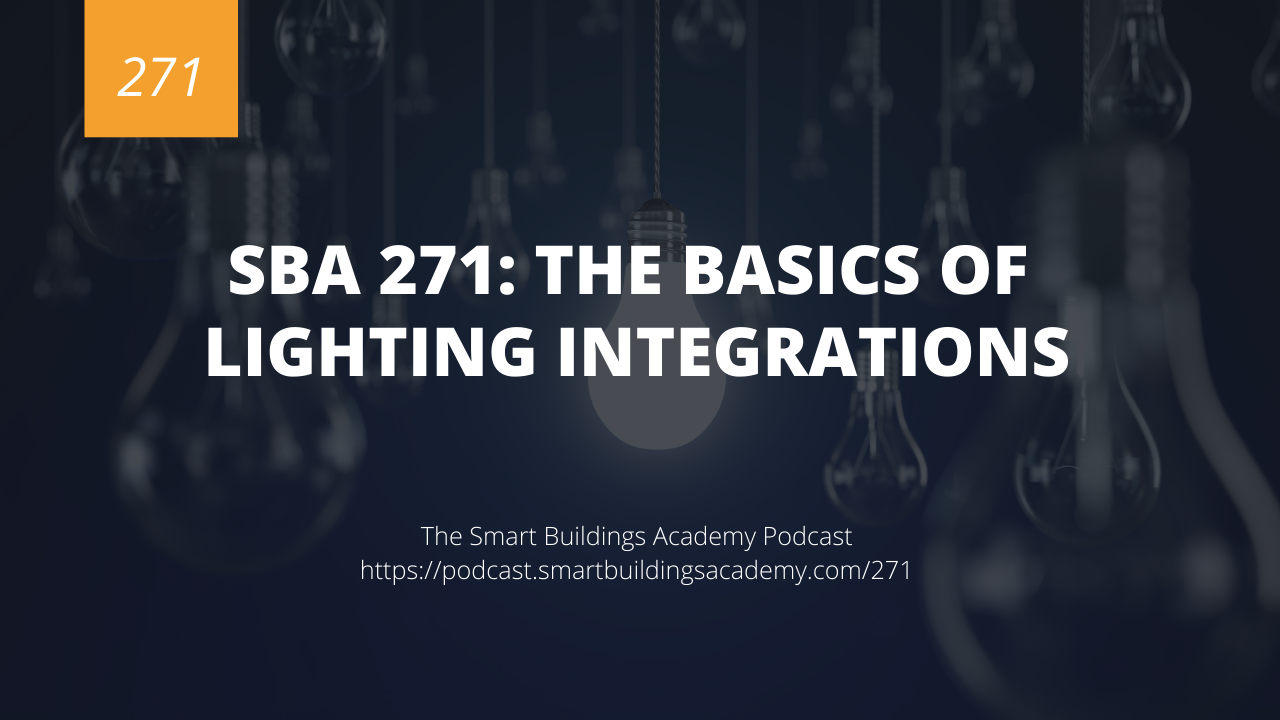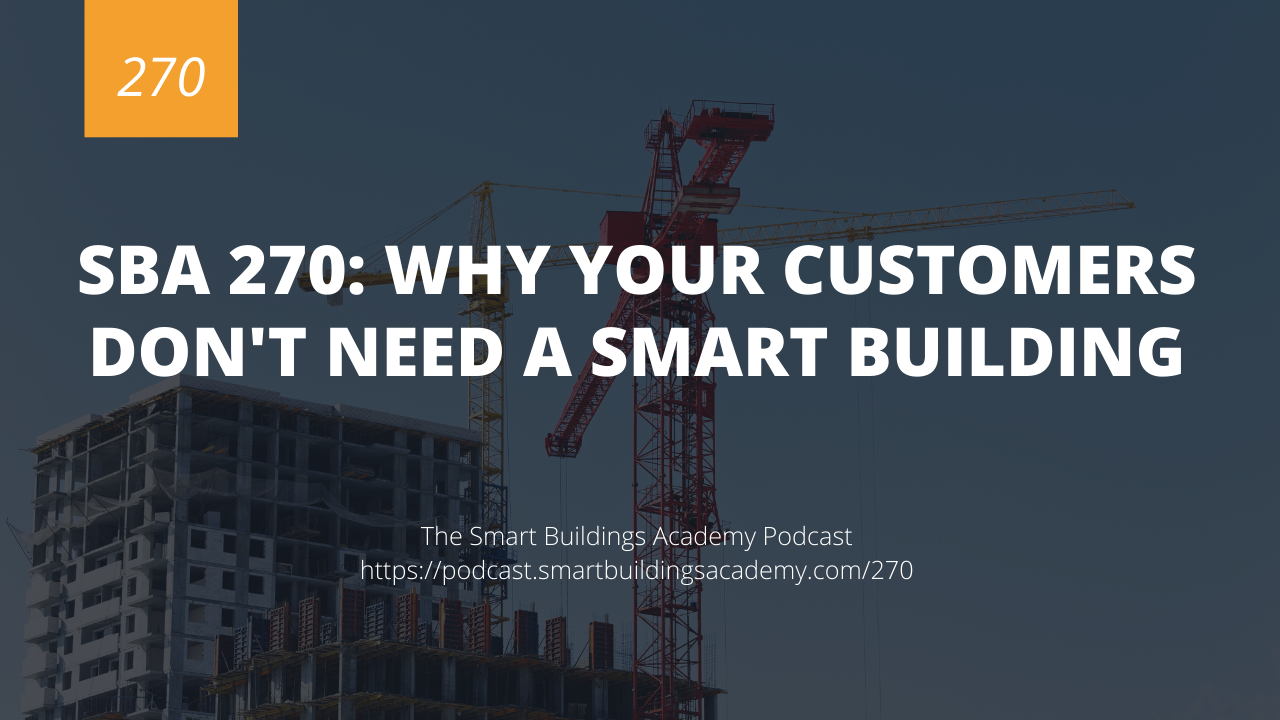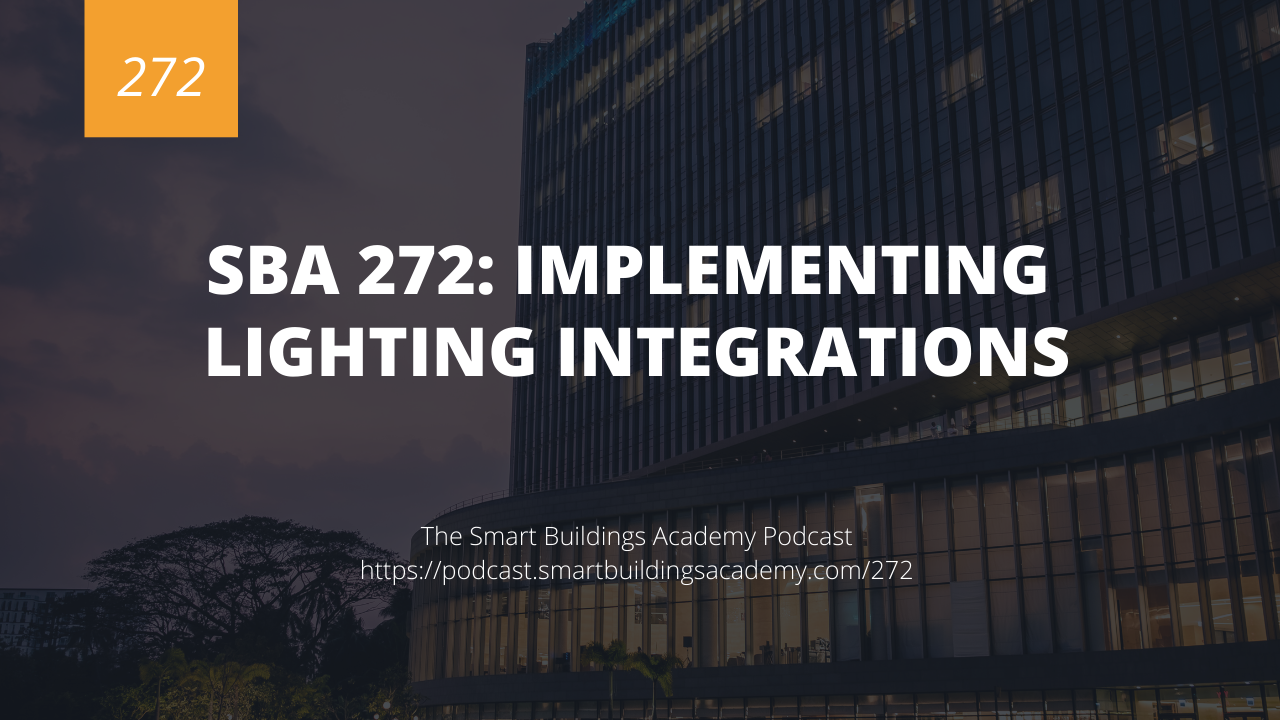In this episode we are starting a multi-part series on integration. In this series you will learn strategies, tips, and tricks on how to approach and maintain simple and complex integrations.
This episode will cover the basics of lighting integration.
What is lighting integration?
What nuances do we need to look out for when integrating lighting systems.
Click here to download or listen to this episode now.
Resources mentioned in this episode


Transcript
Phil Zito 0:00
This is the smart buildings Academy podcast with Phil Zito Episode 271. Hey folks, Phil Zito here and welcome to Episode 271. And in this episode we're going to be kind of stepping a little bit out of where we been in the past, which has been sales and retrofits and technology. And now we're going to be diving deep for at least the next nine sessions into integration. Now, for a lot of you integration is something that is challenging. And, you know, I was in a live office hours for our students last Friday, and I said something and I said to them, I hope this doesn't come across as offensive. And I'm going to say to you, I hope this doesn't come across as offensive. But I am surprised as an industry how much we still struggle with integration, how much it seems like, every time I talk to someone, and I bring up the word integration, I get groans I get eye rolls. Again, you know, that integration crap. And it's doesn't have to be that way. integration in and of itself really isn't that difficult. But I find that people don't have a process and, and I was guilty of this, where you just kind of change settings until it works. And then you're like, Hey, don't touch it, it's working now. Leave it alone. And there's got to be a better way. And that's what we're gonna look at over the next several, probably like nine to 12 podcast episodes. Alright, so as always, everything can be found at podcasts, smart buildings, academy.com, forward slash 271. Once again, this podcast at smart buildings Academy, four slash 271. And if you find my process interesting, if you find the integration process interesting, then I encourage you to check out our system integration Bootcamp, a link to that course will be at podcasts at smart buildings Academy comm forward slash 271. So today, we are going to take up arguably the most common integration outside of h V AC equipment. So obviously, the most common integration would be integrating other building automation controllers, followed by integration, integrating HVDC systems. But outside of that the most common in my experience has been lighting. And there's a lot to lighting integrations. So the first thing I want to do is I want to talk about the structure of a control system, because it's my belief that if you understand the structure of a control system, and kind of how the structure and frameworks are universal, despite the different types of systems, that you'll find integrating systems a little bit easier. So lighting, audio, visual access, control, parking, management, work order management, all of these systems are fairly similar in their architecture. And when I say architecture, I'm talking about their physical architecture, meaning that majority of them have a server. They have a supervisory device, they have field controllers, and I O. So you may be saying, Okay, what does this look like in lighting? Well, in lighting, we have a lighting server. And then from that lighting server, we go to lighting control panels. Now these may be control panels, these may actually be little controllers on the, what do you call it on the ballasts themselves. So you know, it's kind of like a three tier IP architecture without the IP in some cases, then from there, we have our i O, like our input would be our light switch, right, that turns things on and off and our output would be our light and those are controlled by the lighting controllers. Now the lighting controllers themselves could be very simple on off lighting controllers, they could be everything from multiple dim levels, lighting zones etc. And so when I look at any system and this is for lighting this for audio visual this access control right access control has card readers they're an input has locked their output has the card controller then has the supervisory device that has the server side with audio visual right audio visual has touchscreens, has projectors has the room controllers has the main supervisory controller and the server is all tied together. The first thing I want to think of whenever I am working with any kind of integration, and this specifically lighting integration is what is my point of integration. And this is going to be key. Because when we are integrating with other controllers, we're often just consuming data and adding them under the purview of our existing control system. So when we are integrating existing VA s controllers, we're basically integrating them and making them part of our B As system,
Phil Zito 5:00
and so they're controlled by our PA system. But when we're doing these, like, third tier, you know, lighting control, audio visual control, access control, what we're actually doing is we're going and pulling in. And I'm not going to repeat this every time we go through a new type of integration. But this is kind of core knowledge. So if you don't get this, you're not going to understand basically anything else through the entire series. But as we're integrating our lighting, audio, visual, whatever, we have to decide at what point do we integrate, and we have to decide what system takes control. So for example, the lighting server, right, that's most likely gonna have zone control, it's gonna have different levels of control, it's gonna have lighting, you know, the warmth of the light, the just all sorts of things, right. And based on that, you can control that tech, possibly through integration. Or you can have the lighting system control that. And so we got to figure out like, what system is taking charge. And this is where I see a lot of integrations go wrong, when we get outside of hva. cmbs is we never really firmly sit down, we get a spec plan and spec job, maybe a design build job, if we're lucky. We get a spec and it says to integrate the lighting system. And it says to, you know, look at the related section, which is lighting control. And the lighting control section has a sequence and then the control section, right, it has a sequence that maybe says integrate lights turn on lights based on occupancy, but then it doesn't declare, you know, who controls the lights? Do we control them through the UI? Which system takes priority? You know, if something is scheduled in the lighting system, does that take priority? If something scheduled in the BA s system does that take priority? So the process, which we'll cover in the next episode of actually implementing these lighting integrations becomes very dependent on what are we doing from a who's on first perspective, right? What system is in control? So that's our first primary question, right is what system is in control, then once we know what system needs to be in control, then we can decide at which point we want to integrate. If we know the BA s system is going to be taking full control of the lighting system, then we can go and integrate to the ballasts themselves, if possible, or maybe through the server. But we will be writing if the lighting system supports back net at a higher priority. So that way, we overwrite whatever the lighting system is doing, because we are taking primary control. Now flip that if the lighting system has primary control, we'll be writing at a lower priority so that the lighting system can go and reflect that. Now the challenge becomes when this isn't properly communicated to the customer. And the customer has a lighting server with a, you know, a control screen in a closet. And then they have the lighting control on the VA s graphics. And they're trying to change the lighting control to be as graphics. But it's instantly being overwritten by the lighting control from the server because the lighting system has primary control. And so if you're not able to communicate this, and identify this, you're going to get a lot of warranty calls, you're going to get a lot of issues. And I mean, this is true of access control, audio, visual lighting, parking, management, etc. So we just need to be cognizant, right First off, what systems in charge. And then we have to find a way to communicate that information to the end user so they understand what systems in charge. So much of integration is going and balancing out. You know what systems in charge? How do we communicate that to the customer. But then there's also this third thing and it I find it to be not so true for access control, but definitely true for lighting and audio visual control. And it's the mismatch of data types and data structures. So for example, you have an hv AC system, and that hv AC system has a thermostat. And that thermostat is serving temperature data to multiple VA v boxes, right so you got multiple v v boxes or maybe you've got a single v v box with multiple diffusers going into multiple spaces. But what happens is you have this space concept I am in hv see controlling spaces, space 101 space one or two, whereas enlightening and somewhat in audio visual, but primarily lighting, you're taking a zone approach. She may have a lighting zone that stretches across multiple spaces.
Phil Zito 9:43
And this is where we start to get into more advanced control. I see people begin to mess up the integration. As an integrator. It's not only your responsibility to understand the sequence, it's not only your responsibility to understand what system is going to be in charge, but It's also your responsibility to understand how do I align up objects? And how do I align up devices. So that when I am controlling lighting zone 101, which actually overlaps spaces 1011, or two and 103, that I am reflecting that in the graphics, I'm tying to systems properly, I'm properly executing sequences, etc. so common examples of this are you got an open area with a lighting zone that stretches across that entire open area and maybe even covers some interior office space. But then you've got HVC systems where that, you know, open area is a space, and then the internal spaces or spaces as well. So you have to do some data mapping and some data matchup. And this is something I don't see a lot of people do. And then they wonder why, hey, the lights are on, but the H vac isn't on or they checks on but the lights aren't on. And things get a little messy. Alright, so those three kind of key concepts, right, understanding the sequence, understanding the structure, who's on first and mapping data. Now let's get into the basics of lighting integration. Sliding integration is pretty simple, right? We've got three primary ways in which we integrate, we've got direct hardwire integration, where we actually implement our own relays and we can make him break, you know, power relays to entire lighting circuits or to an individual fixtures. The second way is going to be protocol integration. This may be Dolly, this may be k and x. This may be back net may be lawn, but it's some sort of protocol integration. And what protocol integration, it becomes very important that we understand the data types, and we understand what priority these data types have. So you know, for integrating ballasts and zone controls and lighting levels, are we getting full control over that? Or is it being controlled at the server, and we're getting like read and, you know, temporary overrides capabilities, then we also have API integrations, these are becoming more common, but just realize that this is kind of one of the more difficult ways to integrate for most VA s contractors, because they don't know how to write scripting, a lot of them don't have the capability to consume API's natively into their ba SS yet. And so because of this, you got that issue. And also, you have the issue of API deprecation and version management. So you go and upgrade your API version, and then all of a sudden, the functionality that's in that version gets deprecated means it gets removed. And now you've got to go and re initiate your integration. So from a lighting perspective, the majority of the systems are going to be BACnet integrations, here in the United States, overseas, it's going to be a little different. based on where you're at, you're going to typically integrate directly to the server. That's the most common way when you're doing protocol integration. And you're typically typically going to be dependent on the whatever priority level is exposed to you from an integration perspective, back nets a little more forgiving than others. That being said, the cat next and Dolly tend to have more capabilities because they are more total room control or lighting focused protocols. Whereas BACnet is kind of a more general purpose Control Protocol with read property right property definitely BACnet has lighting objects, I will tell you, in my experience that at the time I last worked with lighting integrations, there weren't a lot of vendors who were supporting the lighting objects that come with BACnet. That may have changed. I not professing to know every lighting system out there and every possible way to integrate every lighting system via BACnet. My will tell you that in my experience, it's been typically read and write property that you discovered and maybe device objects that you discovered. And this would typically be BACnet IP via the lighting server.
Phil Zito 14:12
Now we'll get more into actually implementing step by step I told you, it's important to have a step by step process when it comes to integration. And we'll be talking about that in Wednesday's episode where we'll be talking about implementing lighting integrations, we'll look through three scenarios a physical integration, a protocol integration and an API integration. And I encourage you, as we go through this series, we're going to be talking about a lot of integration. We're gonna be talking about a lot of different systems. If you have a question, go into the comments at podcast at smart buildings. academy.com, forward slash 271. Once again, that's podcast, that smart buildings Academy, four slash 271 ask your question, leave a comment. I think I should cover things differently, let us know. And there you have it, folks, the basics of lighting integration and the basic fundamentals of integration. In and of itself, if you found this fascinating and you'd like to know more, I encourage you to check out our system integration Bootcamp, which is a full turnkey course on master systems integration work. And I encourage you to check that out at podcast at smart villains academy.com forward slash 271. Thank you so much for being here. I look forward to talking to you next Wednesday.
Unknown Speaker 15:19
Take care





